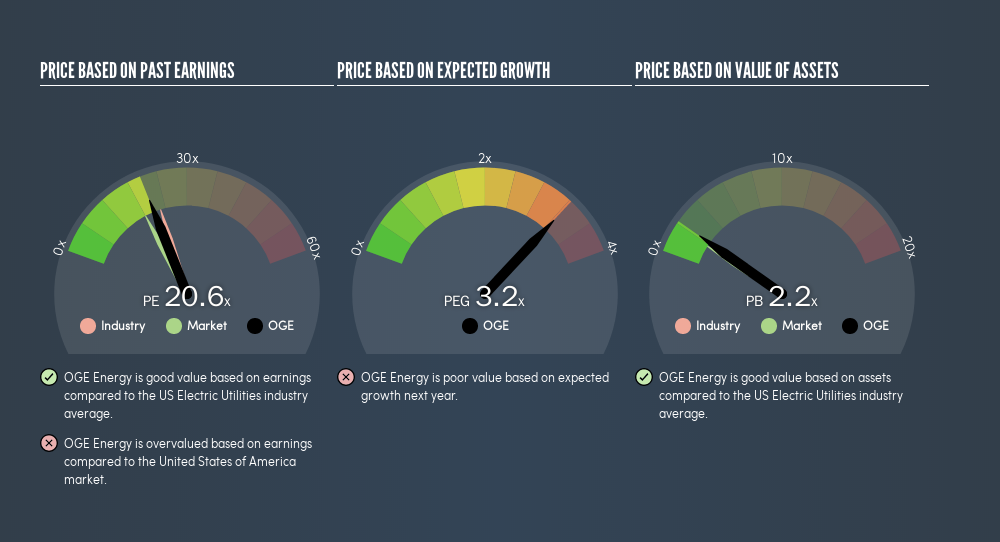- United States
- /
- Electric Utilities
- /
- NYSE:OGE
Is OGE Energy Corp.'s (NYSE:OGE) P/E Ratio Really That Good?

Want to participate in a short research study? Help shape the future of investing tools and you could win a $250 gift card!
Today, we'll introduce the concept of the P/E ratio for those who are learning about investing. We'll look at OGE Energy Corp.'s (NYSE:OGE) P/E ratio and reflect on what it tells us about the company's share price. Based on the last twelve months, OGE Energy's P/E ratio is 20.65. In other words, at today's prices, investors are paying $20.65 for every $1 in prior year profit.
Check out our latest analysis for OGE Energy
How Do You Calculate A P/E Ratio?
The formula for P/E is:
Price to Earnings Ratio = Share Price ÷ Earnings per Share (EPS)
Or for OGE Energy:
P/E of 20.65 = $43.17 ÷ $2.09 (Based on the year to March 2019.)
Is A High Price-to-Earnings Ratio Good?
A higher P/E ratio implies that investors pay a higher price for the earning power of the business. That is not a good or a bad thing per se, but a high P/E does imply buyers are optimistic about the future.
How Does OGE Energy's P/E Ratio Compare To Its Peers?
We can get an indication of market expectations by looking at the P/E ratio. If you look at the image below, you can see OGE Energy has a lower P/E than the average (22.5) in the electric utilities industry classification.

OGE Energy's P/E tells us that market participants think it will not fare as well as its peers in the same industry.
How Growth Rates Impact P/E Ratios
P/E ratios primarily reflect market expectations around earnings growth rates. That's because companies that grow earnings per share quickly will rapidly increase the 'E' in the equation. That means even if the current P/E is high, it will reduce over time if the share price stays flat. Then, a lower P/E should attract more buyers, pushing the share price up.
OGE Energy saw earnings per share decrease by 35% last year. But EPS is up 18% over the last 3 years.
Don't Forget: The P/E Does Not Account For Debt or Bank Deposits
One drawback of using a P/E ratio is that it considers market capitalization, but not the balance sheet. That means it doesn't take debt or cash into account. In theory, a company can lower its future P/E ratio by using cash or debt to invest in growth.
Such spending might be good or bad, overall, but the key point here is that you need to look at debt to understand the P/E ratio in context.
OGE Energy's Balance Sheet
Net debt is 37% of OGE Energy's market cap. You'd want to be aware of this fact, but it doesn't bother us.
The Verdict On OGE Energy's P/E Ratio
OGE Energy's P/E is 20.6 which is above average (18) in its market. With a bit of debt, but a lack of recent growth, it's safe to say the market is expecting improved profit performance from the company, in the next few years.
Investors have an opportunity when market expectations about a stock are wrong. People often underestimate remarkable growth -- so investors can make money when fast growth is not fully appreciated. So this free visualization of the analyst consensus on future earnings could help you make the right decision about whether to buy, sell, or hold.
Of course, you might find a fantastic investment by looking at a few good candidates. So take a peek at this free list of companies with modest (or no) debt, trading on a P/E below 20.
We aim to bring you long-term focused research analysis driven by fundamental data. Note that our analysis may not factor in the latest price-sensitive company announcements or qualitative material.
If you spot an error that warrants correction, please contact the editor at editorial-team@simplywallst.com. This article by Simply Wall St is general in nature. It does not constitute a recommendation to buy or sell any stock, and does not take account of your objectives, or your financial situation. Simply Wall St has no position in the stocks mentioned. Thank you for reading.
About NYSE:OGE
OGE Energy
Through its subsidiary, operates as an energy services provider in the United States.
Solid track record, good value and pays a dividend.
Similar Companies
Market Insights
Community Narratives



